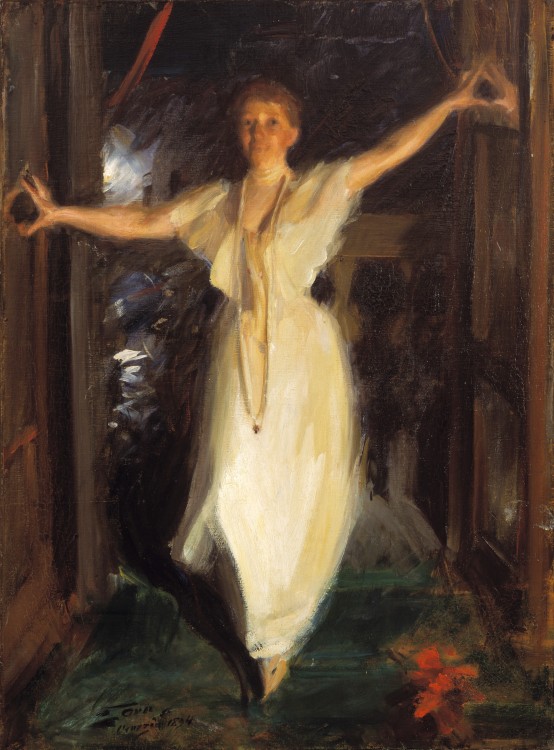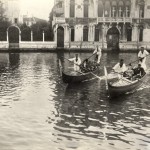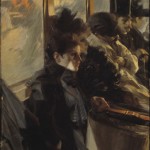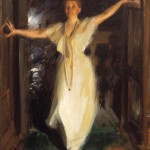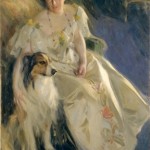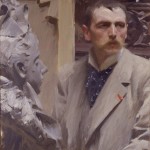In an effort to leave future generations of Americans the lasting legacy and beauty of art, Isabella Stewart Gardner, along with many of her contemporaries including Henry E. Huntington, J. Pierpont Morgan and Henry Clay Frick, amounted some of the most important collections of European masterpieces in the country. "I fancy I am the only living American who puts everything into works of art and music; I mean, instead of into show, and meat and drink," wrote Isabella Stewart Gardner in a letter dated March 25, 1900 to Bernard Berenson, her long-time art advisor.
Gardner not only passionately collected art that spans from Ancient Egypt to the early 20th century, she was also patron to living artists, nurturing the careers of stained glass artist and book designer Sarah Wyman Whitman, painters Joseph Lindon Smith and Anders Zorn among many other influential artists and writers. Anders Zorn, the Swedish Impressionist and contemporary of the American Impressionist John Singer Sargent, is currently the subject of the first historic exhibition in the museum’s new wing, designed by the internationally renowned workshop of Renzo Piano.
 Portrait of Isabella Stewart Gardner in Venice, 1894, Anders Zorn (Swedish, 1860-1920), Isabella Stewart Gardner Museum, Boston
Portrait of Isabella Stewart Gardner in Venice, 1894, Anders Zorn (Swedish, 1860-1920), Isabella Stewart Gardner Museum, BostonLocated in the Hostetter Gallery —a small space that I believe will limit the scope and depth of future historic exhibitions (or contemporary art exhibitions for that matter)—on the museum’s second floor, Anders Zorn: A European Artist Seduces America features more than 40 works, a vast number of these small in size, thematically arranged in sections dedicated to society portraits, city, country, studio and lastly, Gardner’s friendship with Zorn. Curated by Oliver Tostmann, William and Lia Poorvu Curator of the Gardner Collection, the exhibition is organized around Zorn’s famous 1894 portrait of Mrs. Gardner in Venice, the focal point from which many facets of Zorn’s life and career emerge, including his long lasting friendship with Gardner.
The portrait, titled Isabella Stewart Gardner in Venice was painted during the artist’s stay with the Gardners at Palazzo Barbaro in Venice, a place that spawned, fostered and invigorated many of the Gardners' artistic relationships. Traditionally smaller in size, it depicts Mrs. Gardner casting open the windows of the palace’s balcony. Caught in a fleeting moment by Zorn, the artist shows Mrs. Gardner’s youthful personality shining through the night, made more radiant by her shimmering evening gown lit by the moon.
In a letter to protégée Joseph Lindon Smith, Isabella Stewart Gardner expressively describes the painting as "a night scene, painted by night. I am on the balcony, stepping down into the salone pushing both sides of the window back with my arms raised up and spread wide! Exactly like me."
Hailed by critics as a fresh face in the 1890s, Anders Zorn became a celebrity artist during America’s Gilded Age. Much of his successes in this country are attributed to Gardner’s enthusiasm for his works, which she promoted extensively in and around her social circles.
The exhibit, the first in more than twenty years to examine Gardner’s friendship with Zorn, draws heavily from the Gardner museum’s own collection. It includes one of the artist’s most celebrated paintings, The Omnibus, as well as ephemera that illustrate the pivotal role Mrs. Gardner played in advancing Zorn’s career in the United States.
The Omnibus, gave birth to the long friendship between Gardner and Zorn and is exhibited here alongside a more seductive, earlier version on loan from the Nationalmuseum in Stockholm. The conservative version was first shown in the 1893 World’s Columbian Exposition in Chicago, where Isabella Stewart Gardner bought it on the spot. It not only shows Zorn’s interest in the hustle and bustle of city life, but we can clearly see his technique and good sense of coloring, two things he learned by studying the works of Velazquez and Manet.
Tostmann’s decision to exhibit the two versions of The Omnibus side by side is a smart one, for it illustrates how Zorn was able to seduce America by appealing and catering to different segments of American society—different tastes and social backgrounds. Zorn’s careful attention to brushstrokes, coloring and lighting appealed to Americans in attendance at the World's Columbian Exposition.
Primarily known for his society portraits (four of which are displayed here, including the fabulous Mrs. Walter Rathbone Bacon from the collection of the Metropolitan Museum of Art), Zorn also showed an interest in landscapes and nudes and of those on display here, is the phenomenal Opal owned by the Worcester Art Museum.
The exhibition is accompanied by a fully illustrated catalogue with scholarly essays that explore in depth Gardner’s relationship with Zorn and her circle of friends-a segment of which was previously highlighted in the 2004 Gardner Museum exhibition Gondola Days: Isabella Stewart Gardner and the Palazzo Barbaro Circle.
In looking back at the exhibit, I keep thinking about the size of the gallery in which it is being shown and wonder how many more examples of Zorn's works we could have seen and experienced, had the gallery in the new wing been much more carefully thought out. Although the exhibit is limited to the Hostetter Gallery, thankfully, other works by Zorn can be seen in the historic Cummings and Sears building, just as Mrs. Gardner left them to be admired and enjoyed by the public.
- Gardners and Zorns in gondolas, Venice, 13 Oct. 1894, Isabella Stewart Gardner Museum, Boston
- The Omnibus, second version, 1892, Anders Zorn (Swedish, 1860-1920), Isabella Stewart Gardner Museum, Boston
- Portrait of Isabella Stewart Gardner in Venice, 1894, Anders Zorn (Swedish, 1860-1920), Isabella Stewart Gardner Museum, Boston
- Mrs. Walter Rathbone Bacon (née Virginia Purdy), 1897, New York, Metropolitan Museum of Art, © Metropolitan Museum of Art, Image source: Art Resource, NY
- Opal, 1891, Anders Zorn (Swedish, 1860-1920), Worcester Art Museum, Worcester, Massachusetts
- Self-Portrait, 1889, Anders Zorn (Swedish, 1860-1920), Florence, Galleria degli Uffizi, Soprintendenza Speciale Per Il Polo Museale Fiorentino
Anders Zorn: A European Artist Seduces America is on view at the Gardner Museum until May 13, 2013.

